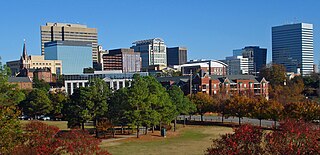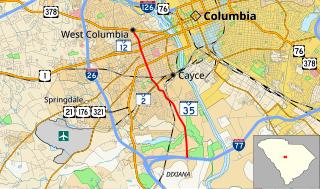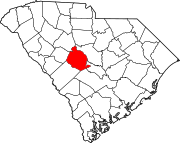
Columbia is the capital of the U.S. state of South Carolina. With a population of 136,632 as of the 2020 U.S. Census, it is the second-largest city in South Carolina. The city serves as the county seat of Richland County, and a portion of the city extends into neighboring Lexington County. It is the center of the Columbia metropolitan statistical area, which had a population of 829,470 and is the 72nd-largest metropolitan statistical area in the nation. The name Columbia is a poetic term used for the United States, derived from the name of Christopher Columbus, who explored for the Spanish Crown. Columbia is often abbreviated as Cola, leading to its nickname as "Soda City."

Cayce is a city in the U.S. state of South Carolina, along the Congaree River. The population was 12,528 at the 2010 census. The estimated population was 14,009 in 2019, and it is the third-most populated municipality in Lexington County. The city is primarily in Lexington County, with additional, predominantly rural land to the east in Richland County. Cayce is part of the Columbia Metropolitan Statistical Area and is within South Carolina's Midlands region.

Lexington is the largest town in and the county seat of Lexington County, South Carolina, United States. It is a suburb of the state capital, Columbia. The population was 17,870 at the 2010 Census, and it is the second-largest municipality in the greater Columbia area. The 2019 estimated population is 22,157. According to the Central Midlands Council of Governments, the greater Lexington area had an estimated population of 111,549 in 2020 and is considered the fastest-growing area in the Midlands. Lexington's town limits are bordered to the east by the city of West Columbia.

West Columbia is a city and commuter town in the suburban eastern sections of Lexington County, South Carolina, United States. According to the 2010 census, the population was 14,988, and the 2019 population estimate was 17,998. West Columbia is bordered to the east by Columbia, the state capital, across the Congaree River. It is near Columbia's city center or downtown district as well as the South Carolina State House and the Congaree Vista, known locally as "the Vista." The city is bordered to the south by its sister suburb, Cayce. A small portion of the city borders the town of Lexington to the east. West Columbia is part of the greater Columbia, SC metropolitan statistical area.

Andrew Pickens was a militia leader in the American Revolution. A planter, he developed his Hopewell plantation on the east side of the Keowee River across from the Cherokee town of Isunigu (Seneca) in western South Carolina. He was elected as a member of the United States House of Representatives from western South Carolina. Several treaties with the Cherokee were negotiated and signed at his plantation of Hopewell.

The Congaree River is a short but wide river in South Carolina in the United States; It flows for approximately 53 miles (85 km). The river serves an important role as the final outlet channel for the entire Lower Saluda and Lower Broad watersheds, before merging with the Wateree River just north of Lake Marion to form the Santee River.

Fort Motte was developed first as Mt. Joseph Plantation; it was commandeered in 1780 by the British and fortified as a temporary military outpost in what is now South Carolina during the American Revolutionary War. It was significant for its military use as a depot for their convoys between Camden and Charleston, which they occupied. Located along the Congaree River, it is roughly 90–95 miles from Charleston by 21st-century roadways. The British had fortified the big house and surrounds, and it became known as Fort Motte, after Rebecca Brewton Motte, who had been occupying it with her family. During the Patriot Siege of Fort Motte, the plantation mansion was set on fire. The British surrendered at this site.

The Cherokee Path was the primary route of English and Scots traders from Charleston to Columbia, South Carolina in Colonial America. It was the way they reached Cherokee towns and territories along the upper Keowee River and its tributaries. In its lower section it was known as the Savannah River. They referred to these towns along the Keowee and Tugaloo rivers as the Lower Towns, in contrast to the Middle Towns in Western North Carolina and the Overhill Towns in present-day southeastern Tennessee west of the Appalachian Mountains.

The Cheraw people, also known as the Saraw or Saura, were a Siouan-speaking tribe of indigenous people of the Southeastern Woodlands, in the Piedmont area of North Carolina near the Sauratown Mountains, east of Pilot Mountain and north of the Yadkin River. They lived in villages near the Catawba River. Their first European and African contact was with the Hernando De Soto Expedition in 1540. The early explorer John Lawson included them in the larger eastern-Siouan confederacy, which he called "the Esaw Nation."

Keowee was a Cherokee town in the far northwest corner of present-day South Carolina. It was the principal town of what were called the seven Lower Towns, located along the Keowee River. Keowee was situated on the Lower Cherokee Traders' Path, part of the Upper Road through the Piedmont. In 1752 the Cherokee established New Keowee Town nearby, off the traders' path but in a more defensible location.
Interstate 77 (I-77) is a south–north Interstate highway, extending 91.2 miles (146.8 km) in the state of South Carolina, extending from the national southern terminus at an interchange with I-26 near Columbia, north to the North Carolina state line near Rock Hill and Charlotte, NC.
The Congaree were a group of Native Americans who lived in what is now central South Carolina of the United States, along the Congaree River. They spoke a dialect distinct from, and not intelligible by, Siouan language speakers; it is considered unclassified. This was the primary language family of Native Americans in the Piedmont, such as the Catawba. Some linguists, however, believe that the language was related to Catawban Siouan.

Interstate 26 (I-26) is a South Carolina Interstate highway running generally east–west from near Landrum, in Spartanburg County, to U.S. Route 17, in Charleston, South Carolina. It is also the longest interstate highway in South Carolina.

The Battle of Congaree Creek was a four-hour action that took place in the waning days of the American Civil War, fought in Lexington County, South Carolina, on February 15, 1865, just south of Columbia on the site of the former town of Granby.
Emily Geiger (1765–1825) is an American Revolutionary War heroine who was captured by the British while on a military mission as a civilian. She was carrying an important message across enemy grounds when she was captured and questioned. The Tory matron could find nothing on her because Geiger had memorized the message, then eaten it, so they had to let her go. She proceeded, reached the general she had sought, and verbally delivered the message.
Brookland-Cayce High School is a public high school located in Cayce, South Carolina, United States that was built in 1932. Named for the cities of Brookland and Cayce of which it originally served, the school now serves parts of West Columbia, Cayce, South Congaree, Pine Ridge, and Gaston. It is a part of the Lexington County School District Two. Brookland-Cayce is known for its historical value as it has graduated over 85 graduating classes. When the high school first opened it was a segregated school. Brookland was a school for whites and Cayce was a school for whites. Over the years the schools joined together.
The Congarees is a historic archaeological site located near Cayce, Lexington County, South Carolina. The site was established as early as 1691, and served as a frontier outpost, early township settlement, and crossroads of the great trade paths of the Catawba and Cherokee nations. The Fort Congaree back country fort was established on the site in 1718.

South Carolina Highway 35 (SC 35) is a 5.630-mile-long (9.061 km) state highway in the U.S. state of South Carolina. The highway connects the southern part of Cayce and West Columbia.
South Carolina Highway 302 (SC 302) is an 66.200-mile-long (106.539 km) state highway in the U.S. state of South Carolina. The highway travels through mostly rural areas of Aiken and Lexington counties and connects the Aiken with the Columbia metropolitan areas, via Wagener and Pelion.

Olympia is an urban unincorporated area and census-designated place (CDP) in Richland County, South Carolina, United States. It was first listed as a CDP prior to the 2020 census.














